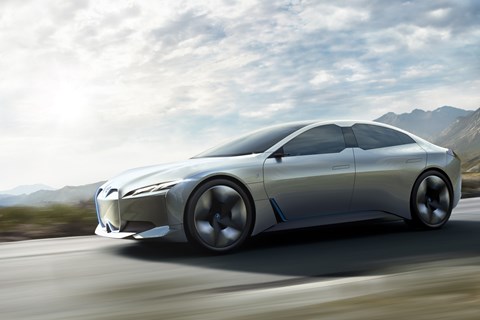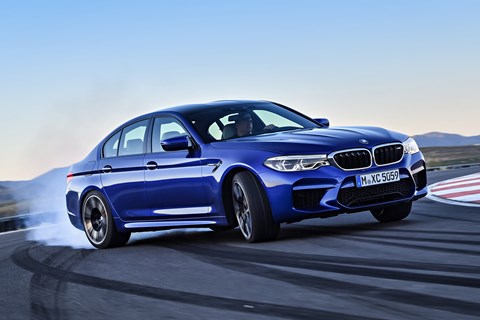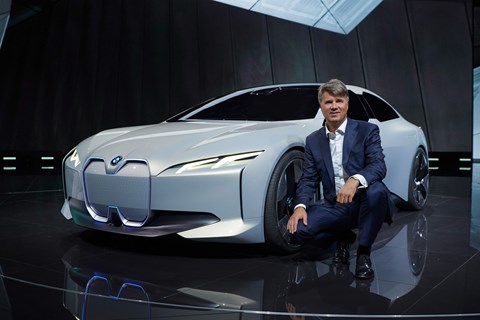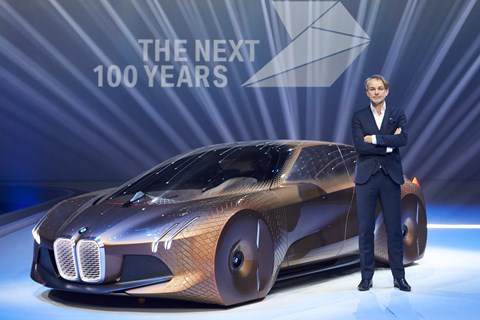► BMW i brand range in detail
► CAR investigates its future…
► …including i5, iNext and autonomy
BMW was out in force at the 2017 Frankfurt motor show – you certainly couldn’t say otherwise. The brand itself revealed several new models and concepts covering almost all customer bases.
For example, its latest M5 uber-saloon shared floorspace with the new premium-SUV-for-the-masses X3, a 6-series GT facelift, an M8-based Le Mans challenger, the X7 iPerformance concept and a facelifted i3 EV hatch.
What came as a surprise, though, was the i Vision Dynamics concept: a new Tesla Model S rival that will go on sale in 2020 that could be named i5. CAR talked to Robert Irlinger, head of BMW i, Dick Arnold, head of product management at BMW i and the Group’s Senior VP for design, Adrian van Hooydonk about BMW i’s hand in the Frankfurt 2017 show and what lies ahead.
The i Vision Dynamics finally plugs the saloon car-sized gap..
There’s a general consensus that the gap between the i3 and i8 needs filling with a car that will appeal to a larger share of the car market. Van Hooydonk said: ‘Ever since we created i3 and i8 there was a lot of room in the middle. i3 and i8 are very different cars, so it always begged the question what will we do between? We are answering that with this car.’
Arnold chimed in to similar effect, and said that its new BMW i concept car ‘is just a logical step to show what you can expect in the future.’
BMW i5: it’s closer to production than you think
BMW’s i concepts have a habit of making production. The i3, for example, started life as the Mega City Vehicle that was first revealed to the world in 2010, with the production version hitting showroom floors three years later.

The i8 was the same. ‘The vision we put out in 2011, which ended up being the i8, took a number of years, then it came to life. If you look at the concept and the production car, you can see they are pretty close,’ said Arnold. ‘This is a good example of what we’ve shown today.’
By these references, we could see the production version of the concept as early as 2020.
The production version could spawn an M Performance variant too
Over the years, we can expect to see BMW’s tech-filled i brand and the racy M Division working closer together than ever before and, over the next few years Team i will end up trickling some of its influence and know-how into more hot BMW cars.
Irlinger told CAR: ‘There will be a blend, or some co-operation in future because electrification brings benefits; full torque from the beginning, for example. There will be M cars with some kind of electrification in the future.’

‘But will you see a clash between i and M? Of course not.’
Arnold added: ‘Over the years, there will certainly be an overlap, no doubt about it. With the i Vision car, it’s one with a broader offer, so I think that will be the time where we see certain blends of BMW i and M.’
Why didn’t they make a family saloon EV in the first place?
With BMW’s vast tech arsenal at its disposal, surely a family car EV would have been the best place to start? Not so much, according to Irlinger: ‘When we started with i3, we thought it was more feasible to start there. When you look at the stats for the i Vision Dynamics (its range, its 4sec 0-62mph time) at that time it was not feasible.’
Battery technology at the time simply wasn’t strong enough to deliver a convincing product, in BMW’s eyes. If they did try it first, instead of the much smaller i3, Arnold says that it could have actually gone against the brand’s emissions goal: ‘The basic idea, at least from the BMW Group perspective, is to lower our CO2 footprint – that’s the real reason we do it. When we introduced the i3 with the smaller battery, it beat every single gasoline car by up to 50% in terms of CO2 footprint.

‘Offering a huge battery with the tech available when we introduced the i3, there was no freaking way that you could have improved your footprint – you could even increase it. The new battery means it’s actually possible now to decrease and improve your CO2 footprint with bigger batteries, as seen in the Vision car.’
There is even another i car in the pipeline…
BMW had already stated earlier in 2017 that another tech-filled project called iNext will be shown in 2021, which will showcase a fourth i car that will join the range in the future. Van Hooydonk explained that ‘the i Vision Dynamics is not the iNext. There is another one that we are working on, that will also sit between i3 and i8.’
The iNext will be a hub for autonomous driving technology, as it will have kit on it that is capable of between Level 3 and Level 5 self-driving abilities. That’s anywhere between traffic jam assist and lane-keeping without regular driver alert warnings, right up to taking you anywhere you want with absolutely zero input on the driving experience.

Irlinger said: ‘You will definitely see further developments with autonomous driving from BMW. The next big step will be with the iNext, where you will see all of the little steps autonomous driving. Everything will be at the pinnacle when it comes to the iNext in 2021.’
Little is known about the shape and styling of iNext. However, if you have a three-strong i range with a city car, family saloon and sports car by 2021, logic dictates that the fourth i car will be some kind of SUV. We have little proof to back that up, but with VW Group firing out electric SUV concepts left, right and centre – it seems the next likely business case in Munich too.
Like other i cars, the iNext will also end up drip-feeding ideas to the rest of the BMW range in future. ‘You will see in the pinnacle, the iNext, that certain technologies will be in a very far developed stage,’ Irlinger told us. ‘Will there be huge demand for Level 5 autonomy in BMW cars? No there won’t, but will there be Level 3 or 4 where you can read your emails? Definitely.
‘When you have a car like the iNext where it has been developed up to Level 5, from then on the mother company can use tech from the pigeonhole of BMW i. Like the use of carbonfibre in the i3 – do we use it in every BMW model right now? No, but we currently use it in the 7-series.’
Unsurprisingly, BMW i is all for autonomous driving…
Naturally, BMW’s futuristic side sees real benefits to autonomous driving, and execs warn that jumping to conclusions that all cars will be pod-like vehicles without steering wheels is still some way off. Arnold said: ‘Thinking about automated driving, it’s something we don’t need to fear as we’re already had it for the last 10 years or so. People have no issue to accept lane departure or emergency braking.’
‘A partly autonomous car is a brilliant idea – a lot of customers already do “autonomous driving” [mimics someone on their phone at the wheel] which is the most dangerous way to use a car! So offering a system which takes away the burden from the driver and lets them use their mobile device, for example.’
Future BMW cars will look cleaner and will look more distinctive, too
We’ve all at least once said that all BMW cars look roughly the same, but van Hooydonk is keen to change that. He told CAR magazine: ‘Of all the cars on show here [i Vision Dynamics, X7 iPerformance, Z4 Concept etc.], you see more variety in the grille treatment – that’s deliberate. We want you to be able to distinguish which models are which in your rear-view mirror. So, sporty cars like the Z4 will have the low wide grille, taller cars like SUVs will be more vertical.

‘If you talk about the Z4, it has a very different and very new facial expression. The grille doesn’t have slats but mesh (like some of our historic grilles), and the headlamp treatment is very different. They’re stacked, which helps give the car much more of a shark nose.’
‘Meanwhile, the whole stature of the X7 is much more formal. It’s just a different type of vehicle, but it’s the same kind of BMW form language.’
Read all our BMW car reviews here